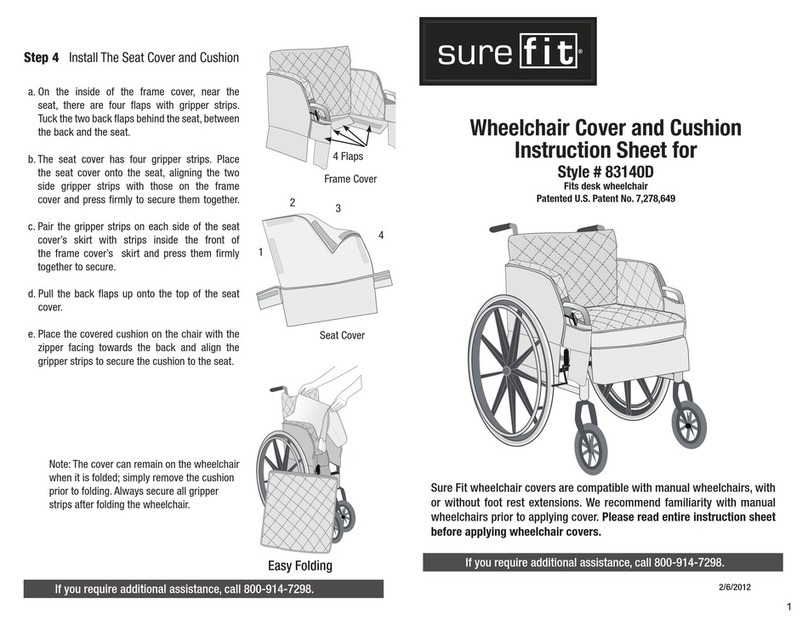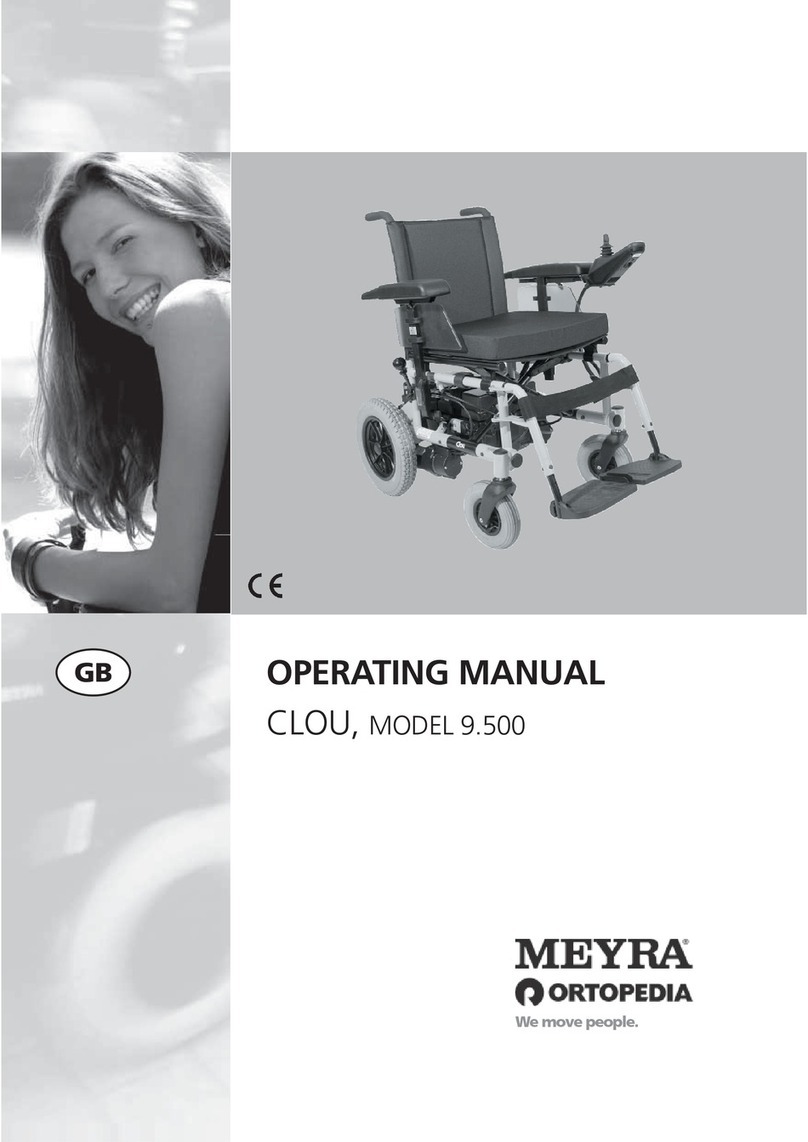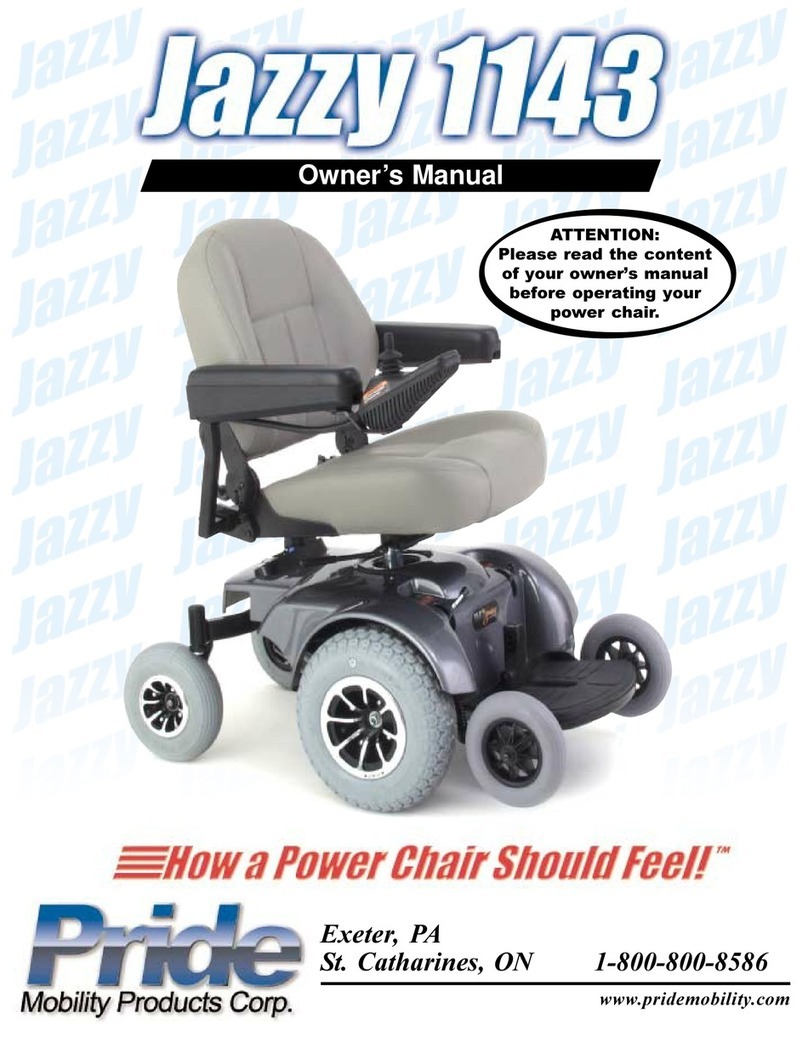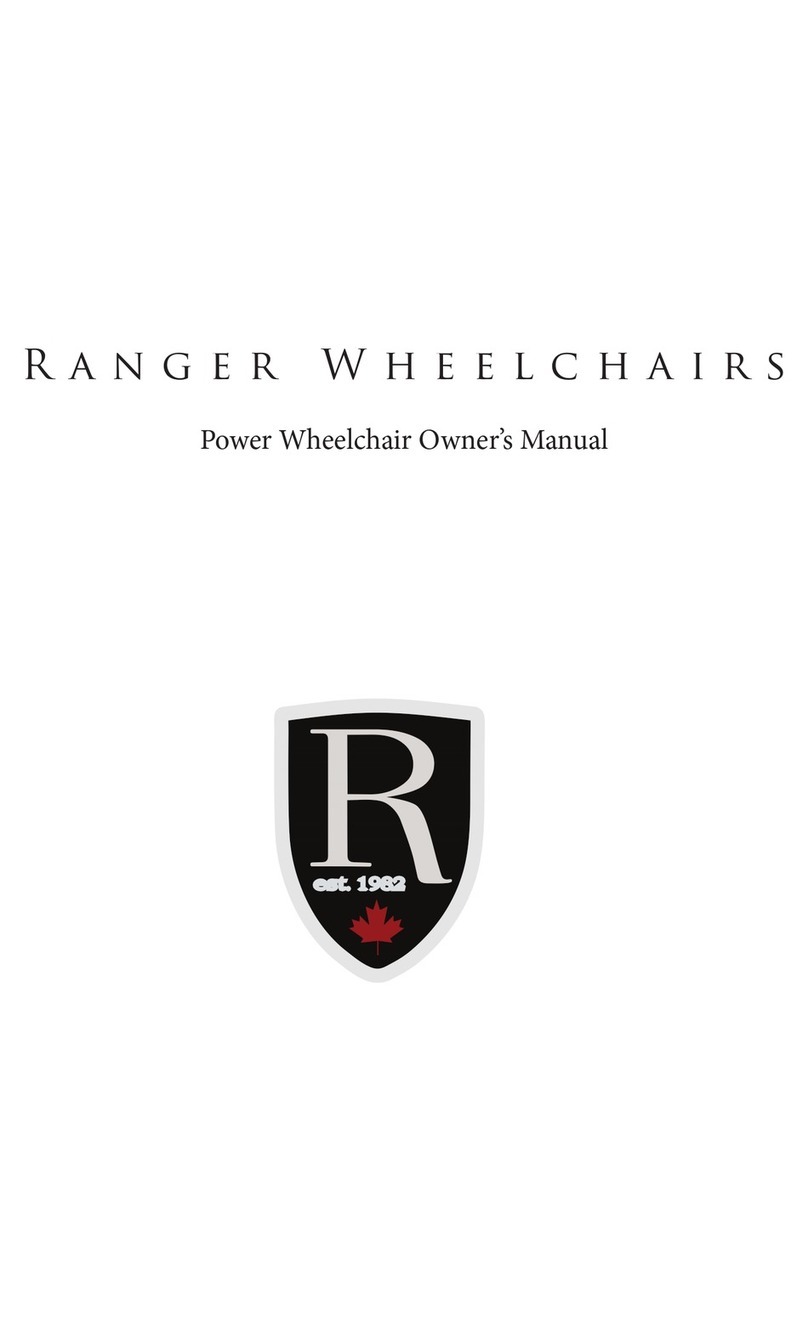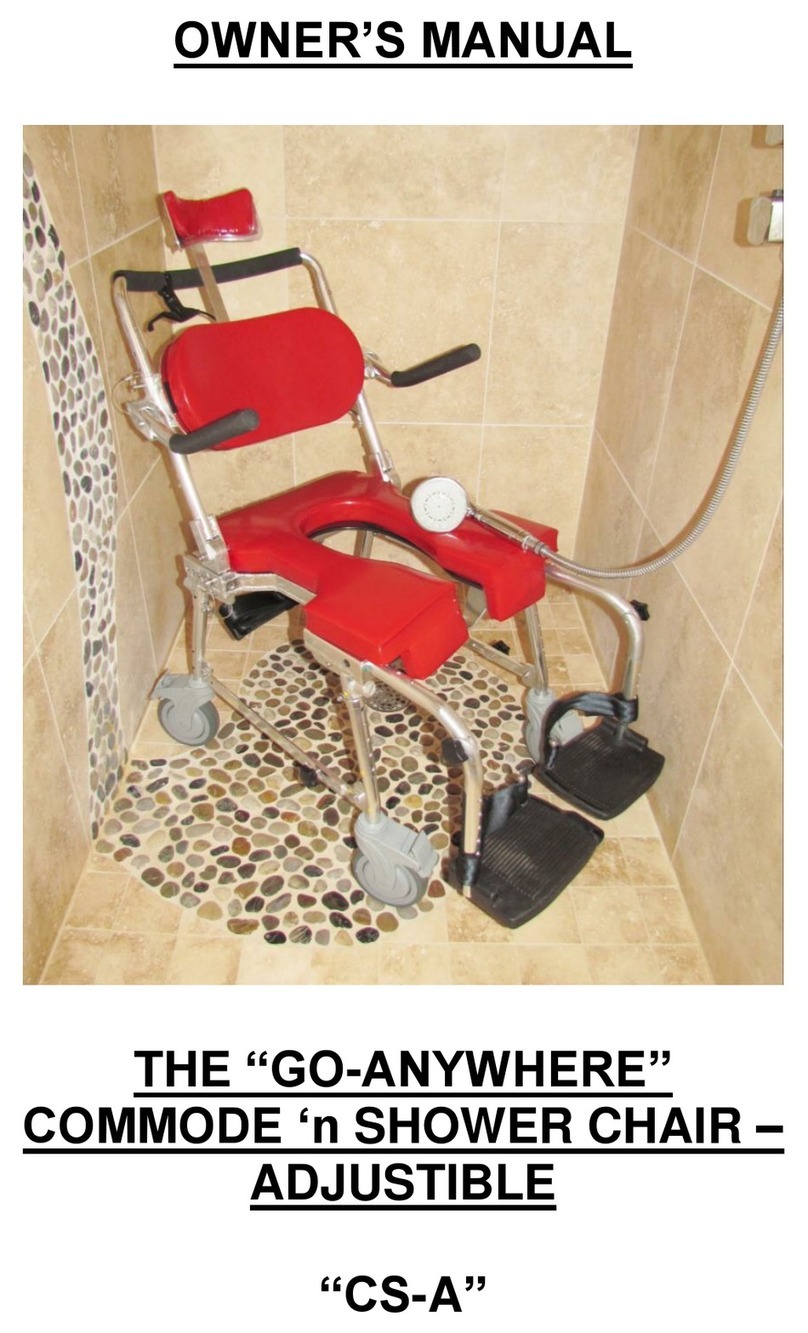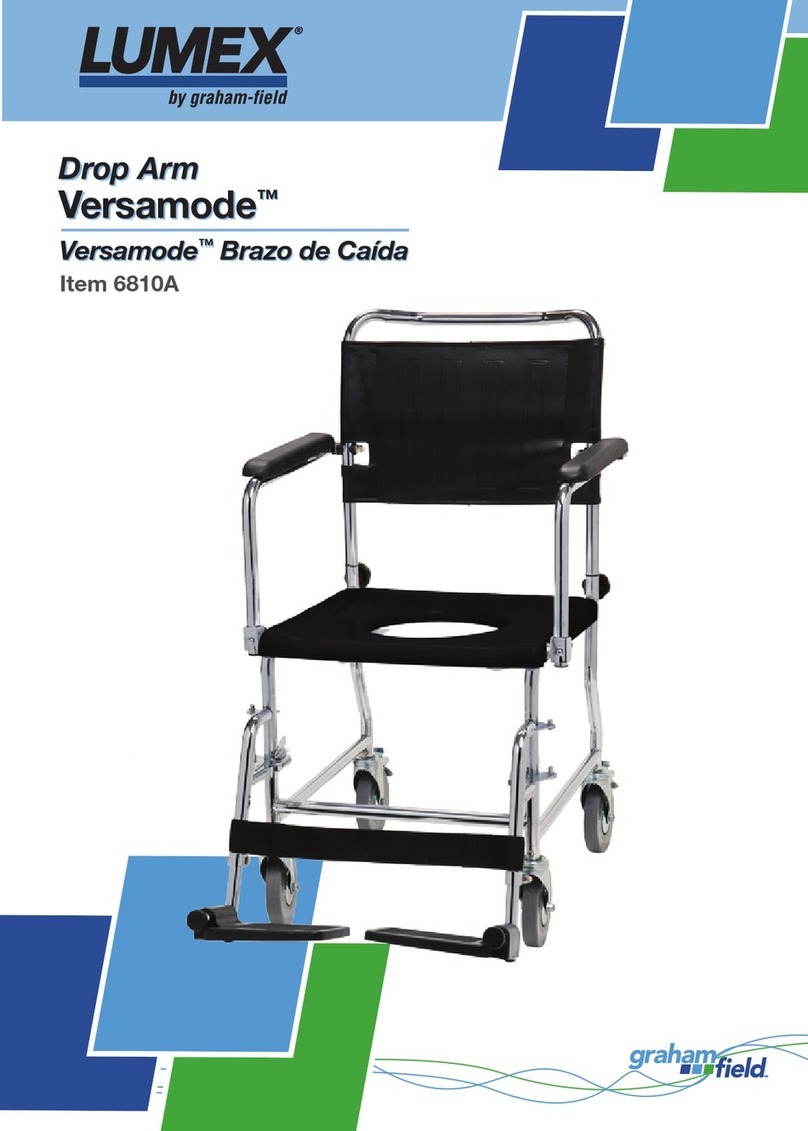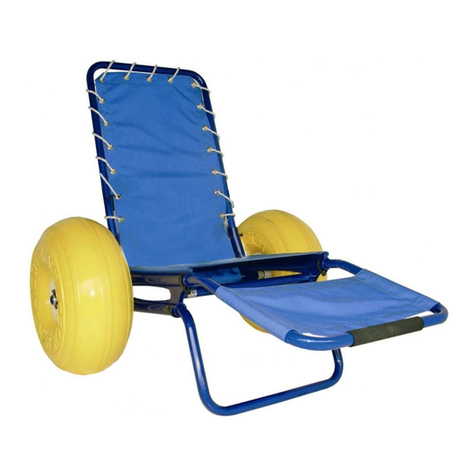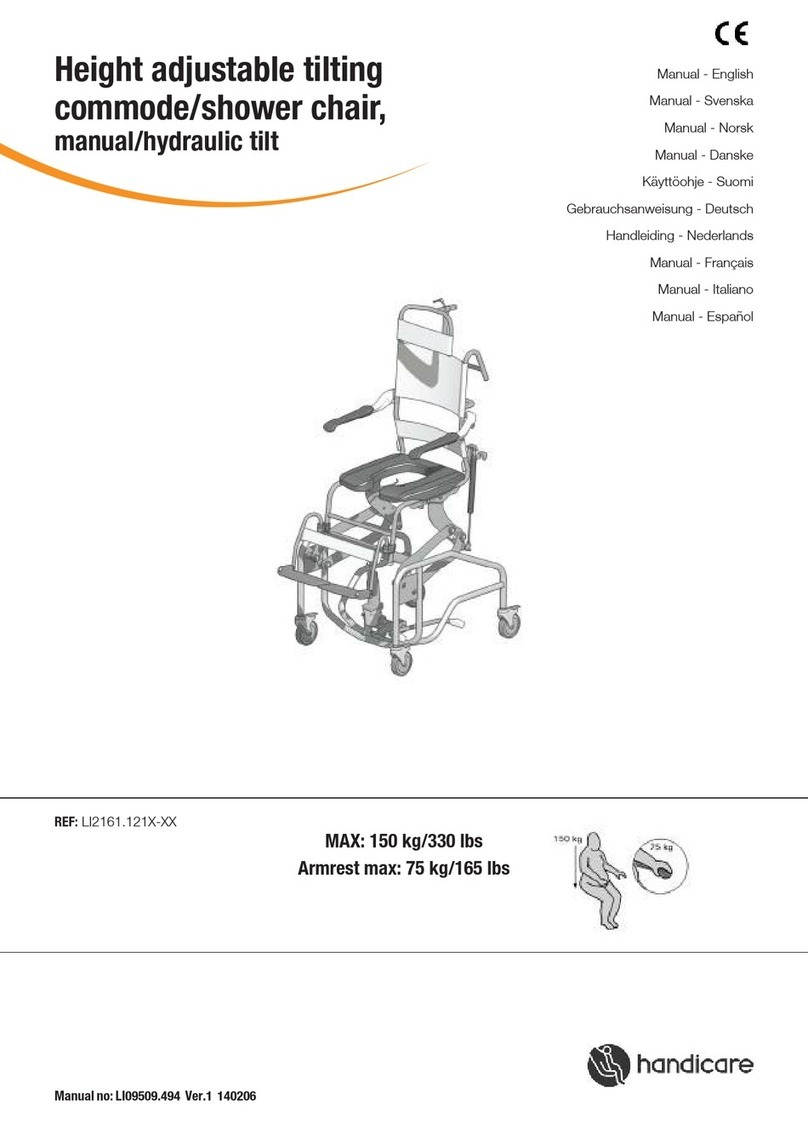Activate MUSTANG User manual

USER GUIDE
Issued 1st September 2009


CONTENTS
Page Subject
1) Introduction
2) Safety Notes
3) Controller Functions
4) Controller Function
5) Fault Warnings
6) Circuit Breaker –Charging
7) Disengaging Motors
8) Seat Functions
9) Seating parts
10) Seating parts
11) Seating parts
12) Occupied Transport
13) Occupied Transport
14) Safety features
15) Care & Maintenance
16) Technical Specification
17) Service Record
18) Guidance for refurbishment and re-use


Welcome to the MUSTANG User Guide
The Aim of the design (EU Community Registered Design number –001161095-0001)
The purpose of the MUSTANG is to meet children’s specific needs in a powered
chair. We have designed the seat position to be appropriate for the occupant. The
overall stability has been achieved for children who have little sense of danger. The
drive wheels have rubber tyres for grip, and are foam filled to remove the risk of
punctures.
When you are planning to take the MUSTANG to a new venue, make sure that you
are aware of steps, rivers, ponds, soft muddy ground and steep slopes. Don’t let the
occupant travel off alone. Always keep near to them to assist them.
The HI-LO facility must only be used on flat level surfaces. It is
possible for the whole unit to tip over on uneven or sloping ground.
Please make sure that the user understands this. Care must also be
taken to ensure that other persons keep clear of the lifting
mechanism –especially when the seat is being lowered –to avoid
entrapment of fingers etc
Activate, or your dealer, cannot accept liability for accidents arising from dangerous
use of the MUSTANG.
You are now in possession of a piece of equipment that is potentially dangerous, but
will broaden your horizons, and ease the frustration involved in limited mobility
1
ENJOY YOURSELVES!

SAFETY NOTES
Please read this User Guide fully before using your MUSTANG
Check with your OT to make sure that they are happy with your child’s function in the MUSTANG.
Before using the MUSTANG it is essential to check that the adjustments are appropriate and the all
handwheels are tightened.
Each supervisor should be familiar with the operation of the MUSTANG. If there is any doubt they should read
this User Guide.
Make sure that the occupant has the appropriate harnesses fitted and adjusted before operating the
MUSTANG.
Before setting off, make sure that no loose clothes etc are likely to catch on the wheels or anything that is
driven past.
Do not try to go up or down kerbs in the MUSTANG.
Do not drive through puddles or into water. The MUSTANG is battery powered, and water will cause a short
circuit and damage the controller.
If the MUSTANG is going to be used for occupied transport, please read this section carefully later in the
Guide.
When transporting the MUSTANG in a vehicle without an occupant, make sure that it is securely tied down to
avoid movement in transit, or in an impact.
Do not let children play with, hang onto, or crowd around the MUSTANG. Distractions can cause accidents.
Make sure that children are clear of moving parts before making adjustments.
Make sure that the power is switched off while loading and unloading from the chair.
Make sure that you are aware of emergency procedures that apply to the venue you are at, and that you know
where the emergency exits are located.
Make sure that the speed is appropriate to the skill of the operator.
Never leave the MUSTANG unattended.
At all times when operating the MUSTANG, be aware of the danger of injury to yourself, the occupant, or any
other person, especially going through doorways and crowded areas.
Activate and your dealer cannot accept responsibility for any loss, damage or injury resulting from the
incorrect operation of the MUSTANG
Weight Limits
The User weight limits for the Mustang relate to the seat unit size
and are displayed on the rear of the seat unit:
Size 1 = 45kg Maximum
Size 2 = 50kg Maximum
Size 3 = 65kg Maximum
The Total weight of the Mustang Wheelchair is 110kg with the
heaviest combination of options. The maximum total weight of the Mustang including the user is
175kg. Any additional equipment should be included in this total maximum weight.
2

OPERATING INSTRUCTIONS
The Remote or Joystick controller.
In this picture you will see the ON/OFF switch in the
centre of the controller near the battery indicator lights.
The eight coloured lights indicate the level of charge left
in the batteries. With all lights showing with full charge,
and red lights being a low charge warning. The Horn is at
the centre of the remote joystick denoted by the bugle
symbol.
The Seat Function button is located below
the On/Off switch. To enter the Seat
Function press this button. The number ‘1’
on the left hand side will show when you are
using the seat raise function, and the number
2 will show that you are in Tilt Mode.
The Seat is raised using an Electric Linear
actuator, which can be stopped in any
position.
The joystick is used to control the seat actuators. To raise the seat in Mode 1, the joystick
should be pulled backwards. Release the joystick when you have reached the desired height.
The Joystick should be pushed forwards for the seat to lower down again.
To tilt the seat back in Mode 2 the joystick should be pulled backwards and then pushed
forwards to tilt to the upright position.
3

OPERATING INSTRUCTIONS
The SHARK D-type controller.
The speed of the CORGI HI-LO is
controlled pressing either the Tortoise or
the Rabbit on the controller as seen in the
picture. The ring of lights indicate the speed
level set. Within this speed setting, the
joystick provides variable speed.
If you find that this is being adjusted to
maximum speed when it would be unsafe,
you may wish to have the controller
programmed to reduce the speed. The
speed settings should be programmed by
your provider. The acceleration speed and
the turn acceleration can be set to be appropriate to the user’s reactions and driving ability
Operating the Lights.
Pressing this button will switch on the
headlights and the rear tail lights. All of the
lighting uses LED technology to reduce the
power requirement and to ensure that the
lighting units do not over heat
To indicate your intentions when turning, the
arrow keys are used to activate the relevant
indicator light on the rear of the chair. If you
are carrying out a confusing manoeuvre
press the triangle button, which will activate
the hazard warning lights on the rear of the
wheelchair
To Immobilise the Mustang, press the ‘On’ button, release, then hold the
‘On’ button down until it beeps twice. This will prevent unauthorised use
of the chair. To release this lock mode, switch ‘On’ and press the horn
button twice
4

FAULT WARNINGS
The following signals may appear and indicate the
following:
Power is on –everything normal
Left red LED is flashing –this means very low
battery charge –charge up as soon as possible,
otherwise the charger will not be able to detect that
it is connected up to a battery and will fail to start
charging
The LED’s are chasing from right to left – this means
that the lock mode has been activated. To unlock the
system press the horn twice within 10 seconds of
switching on.
The LED’s are chasing from left to right, alternating
with a steady display.
This means that the system is being charged or is
in programme mode.
All LED’s flashing slowly – this means that the joystick
has been touched while the system is powering up.
Release the joystick to go back to neutral and the
system will function normally.
5

CIRCUIT BREAKER
If you have no power at all, it is possible that there has been a power surge due to some physical
resistance to the motors. This will have caused the circuit breaker to depress. To power up the
system the circuit breaker should be pressed in again. This is found under the chair at the rear as
shown
Battery Charging.
You will have received a charger with the CORGI HI-LO. The XLR
plug fits into the front of the controller to charge the battery. Always
charge the battery in a well ventilated area.
The charger comes with its own instructions. Please read these
carefully before using.
If you use your Mustang every day, it is best to re-charge
overnight every day to keep the charge topped up
Battery Charger –Design may vary according to
availability
6

OPERATING INSTRUCTIONS
Disengaging the Drive Motors.
There are times when you need to be able to push the MUSTANG along, without using the
controller. For instance:
Moving the MUSTANG into position in a minibus, ready to be strapped down for
transportation.
When the battery has run out of charge!
When you are parking the MUSTANG while it is not in use.
It is important that you re-engage the Gearbox, as it is combined with the brake. We have
found that secondary parking brakes are not suitable, as they are often left on when the power
chair drives away, resulting in damaged tyres.
If you want to stop, and the occupant will not co-operate, you should be able to remove the
controller from its mounting and take charge of it yourself.
The Gearbox/Motors are disengaged by rotating the lever through 90 degrees as shown in the
picture below.
How do the brakes work?
The brakes require an electric current to release them. Therefore when the joystick is
released, the brakes automatically apply. While the chair is parked, the brakes are on. The
brakes release as soon as the joystick moved into the driving position. There are no
supplementary brakes as normally the user forgets to release these brakes and the motors
continue to drive causing damage to the wheels
7

Removing the Seat of the Mustang
The two release levers are pulled upwards together to release the front edge.
The Seat unit will then tilt backwards and can be lifted off the seat interface
8

LATERAL SUPPORT RELEASE
When placing the child into the wheelchair it is advised to swing the
lateral supports away to the sides of the chair. To do this the ball
underneath the attaching block can be pushed up which will release the
support to be swung away.
Ensure that the lateral support is clicked into place while the wheelchair is
in use.
LATERAL SUPPORT ADJUSTMENT
To adjust the positioning of the lateral support there are two bolts on the back of
the seat which can be loosened and the support will then slide up and down, to
the preferred position, and moved in to support the trunk of the occupant.
Please ensure the bolts are fully tightened before using the wheelchair.
ADJUSTING THE ARMREST
To adjust the height of the armrest there is a small hand wheel
which can be unwound to release the grip. The armrest can then
be pulled up or down and re-positioned and the screw then
tightened.
When adjusting the armrest ensure the occupant’s hands are kept
away from the armrest, to prevent catching fingers when
repositioning the armrest.
ADJUSTING THE HIP GUIDE
The hip guide can be adjusted for height by releasing the hand wheel as shown.
INCREASING WIDTH OF HIP GUIDE
To increase or decrease the seat width, the hip guides can be pulled
outwards. This is achieved by using a hand wheel which grips the
main attaching bar of the hip guide to the base of the seat. This
handwheel is found underneath the seat. The hand wheel can be
loosened and the hip guide will then slide out to the preferred
position. The hip guides will slide out individually to fit the occupant.
The hand wheel will then need to be tightened in the new position
before use.
9

MOVING THE POMMEL
The pommel can be taken off the seat to assist with putting the
child in the wheelchair. This can be done by loosening the screw
fitting in the centre (on the underneath of the chair) at the front.
When the screw is loosened, the pommel bar will slide out of the
bar attached to the base, and the pommel will come off the chair.
This can be replaced by sliding back into the holder and the
screw tightened.
Ensure the pommel is firmly secured before setting off.
THE SINGLE FOOTREST
The angle of the footrest can be adjusted by using the lever
handle on the bar underneath. When this lever handle is
unwound, the footrest can be tipped back or forward to re-
position it. When the preferred position is obtained the lever
handle can be tightened. To re-position the handle, the centre
button can be pushed in and the handle moved to a different
position.
TO LOWER THE FOOTREST
If the footrest is too high or too low for the child this can be
adjusted by loosening the bolt on the end of the bar which is
attached inside the legrest tubes. Then the bar can be lowered
or raised to suit the child. When re-positioned, the bolt should be
tightened and the footrest is ready to use.
TO REPOSITION THE FOOTREST
There is also a facility to reposition the entire footrest away from, or in
towards the wheelchair. This is achieved by using the screw fitting on the
side of the chair at the very front, which holds the bar attaching the
footrest to the base. When this screw is loosened the bar can be pulled
or pushed to a new position, and then the screw should be tightened.
The footplate can be removed when stowing the wheelchair into a
vehicle.
10

INDIVIDUAL SWINGAWAY AND FLIP-UP FOOTPLATES
The individual swingaway footplates allow access for self loading. The footrest hangers are
removable, or they can be rotated out of the way. The footplates themselves flip up, which may be
sufficient for some situations.
The footrest hanger fits onto the receiver
as shown, and swings towards the
centre to lock into place.
ADJUSTING THE HEIGHT OF THE SWINGAWAY FOOTPLATES.
The footplates are adjusted for height by releasing the clamp on the footrest hanger, which will
allow the footrest piece to slide in and out to the desired position.
HEADREST HEIGHT ADJUSTMENT
The headrest can be lowered or raised by using the screw fitting on the silver
block at the top of the chair back. When loosened the main bar can be moved
and the screw re-tightened.
Ensure the screw is fully tightened before the child uses the headrest.
TRAY TABLE ACCESSORY
The tray table is fitted into the armrest by a long pin attached to the
underside of the tray, which is inserted into a hole in the end of the
armrest. This will then slide along so the tray is secure around the
child. There is a rubber rim around the edge of the tray to prevent
objects falling off.
11

Using the MUSTANG in occupied transport
The MUSTANG has been crash tested in accordance with ISO7176 part 19. This means that it
is suitable to be transported in a vehicle with the occupant sitting in it. The Seat should be in
the lowered position and tilted to the most upright setting.
The Mustang is held down by four restraints: two at the front, and two at the back. These
should be wheelchair restraints that have been designed for this purpose. The occupant is
secured by a separate occupant restraint, which is anchored at shoulder level to the side of the
vehicle.
Please study the next few pages carefully, to make sure that you are operating in a safe
manner.
The Front Restraints are fitted first, attaching
to the bracket above the front wheel at the
front of the MUSTANG.
The Rear Restraints are fitted and tensioned
to hold the MUSTANG securely as shown.
WHEELCHAIR RESTRAINTS
It is important that wheelchair restraints should be attached at an angle of no more than 45
degrees to the vehicle floor. Make sure that you obtain a copy of the operating instructions for
the restraint system that you use.
OCCUPANT RESTRAINT
The occupant restraint is fitted over the occupant, working like a 3-point vehicle belt, with lap
belt and diagonal belt.
It is important that this fits comfortably over any postural belts that are fitted to the seat.
12

KEY POINTS RELATING TO TRANSPORTATION
1) The Mustang must face forward in the vehicle, in the direction of travel.
2) The Mustang must be restrained with a 4-point wheelchair tie-down. No
other restraint system must be used.
3) The occupant must be restrained with a 3-point passenger restraint,
anchored at shoulder level.
4) The lap belt section of the passenger restraint should fit snugly over the
pelvis of the occupant, at a steep angle of application to avoid abdominal
intrusion.
5) Check with the vehicle converter, that the vehicle floor and sidewall
structures have the appropriate strength required by the restraint
manufacturers for the installation of the restraint systems.
6) Check that the vehicle converter has fitted the restraint system in
conjunction with the restraint manufacturer. All of the restraint
manufacturer’s recommendations and guidance notes should be followed.
7) Check that all vehicle operators are suitably trained in the use, care and
maintenance of the restraints.
13

Safety Features
Each of the arms are fitted with a cut out device, which will
cut off the power supply if the path is obstructed as the
seat lowers.
If an obstruction appears at the front of the chair, this
safety cut-out will operate:
If an obstruction appears under the seat this safety cut-out
device will operate:
14

Care & Maintenance
Your Mustang has been designed and produced to a high standard. With correct use
and maintenance it will give you years of trouble-free service.
Please read the following instructions:
Regularly inspect the frame of the Mustang to ensure that all fixings are secure, and
moving parts are in good working order.
Wheels and tyres are subject to wear. If they need to be replaced, the work must be
carried out by a qualified rehabilitation engineer.
We recommend that the Mustang is checked once a year by a qualified rehabilitation
engineer.
Any damage or repairs should be assessed by a qualified rehabilitation engineer, or
should be returned to your dealer.
Only approved parts should be used when the Mustang is repaired.
The Motor/Gearbox units are maintenance-free. No attempt must be made to remove
the covers.
Wheels and the frame may be sponged clean with warm water and a mild detergent.
Water must be kept away from the battery box and the controller.
After exposure to damp conditions, dry off the frame with a soft cloth, and leave in a
warm, dry environment.
Store the Mustang in a dry, safe place.
15

Technical Specifications
Controller
Dynamic Shark –Standard B-type
Options
Dynamic DX Range/PG range
Motor Type
24V DC
Park Brake
24V
Power Output
230 watt
Max Torque
55 Nm
No. Load Current
3.3A
Output Shaft Speed
120rpm
Gear Ratio
32 : 88 : 1
Max Speed
7km/h (4mph)
Drive Wheel
317.5mm pneumatic with Flexel fill
Batteries
6 x 14A/h (size1) 6 x 20A/h (size2)
Rated Capacity
42Ah (Size 1) 60A/h (Size 2)
Charger
8Ah
Turning Circle
1130mm
Static Stability
10 degrees
Dynamic Stability
10 degrees
Stability figures are based on the Mustang chair with the seat in
the normal lowered position. When the seat is raised the
Mustang should not drive on any slope at all
16
Table of contents
Other Activate Wheelchair manuals


